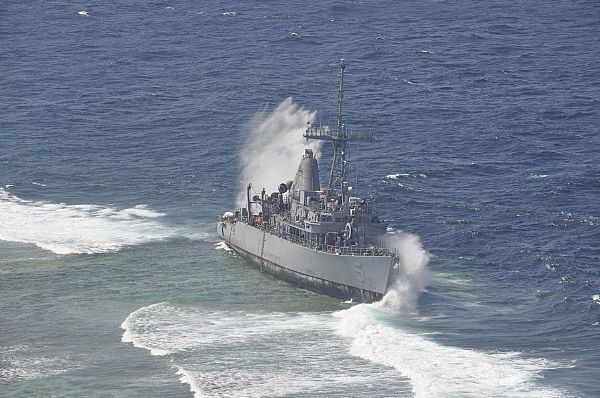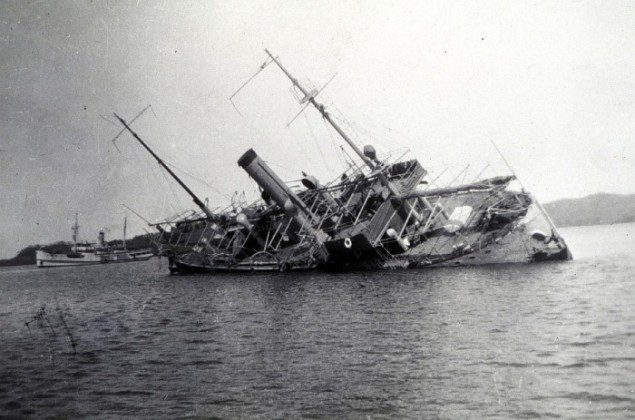Crew Rescued In Red Sea After Attack On Ship Near Yemen
CAIRO, July 6 (Reuters) – The crew of a ship set on fire in an attack in the Red Sea on Sunday abandoned the vessel and were rescued as it took on water, a British maritime agency said, in...

TUBBATAHA REEF (Jan. 22, 2013) The mine countermeasures ship USS Guardian (MCM 5) sits aground on the Tubbataha Reef. (U.S. Navy photo)
By Doug Helton, NOAA
On January 17, 2013, the Navy mine countermeasures ship USS Guardian ran aground on a coral reef in the Philippines. Salvage experts evaluated various options for removing the ship, including towing or pulling it off the reef, but concluded that such efforts would cause even more damage to the reef and the ship’s hull. Earlier this month, the Navy decided to dismantle the ship and remove it in smaller sections in order to minimize damage to the reef and surrounding marine environment.
The Tubbataha Reef, where the ship grounded in the Sulu Sea, is a marine park and UNESCO World Heritage Site, recognized for its biodiversity, pristine reefs, and protected nesting habitat for marine birds and sea turtles.
The photos of the stranded ship and the concern about the corals in this part of the world reminded me of a story about the old U.S. Coast and Geodetic Survey (USC&GS) vessel Fathomer. The USC&GS mission was to survey the U.S. coastline and create nautical charts of the coast to help increase maritime safety. Today, this part of NOAA is called the Office of Coast Survey, which produces navigational products, data, and services to keep maritime commerce moving and to protect life and property at sea.
I came across old photos of the Fathomer when I was working on a project studying the impact of vessel groundings on corals. That story ended quite differently than the USS Guardian, and shows how environmental protection has become a much bigger concern for salvors. In the old days, the focus of salvage was strictly to save the ship and cargo, but modern salvors (salvage crews) have a much bigger emphasis on protecting the environment.
On August 15, 1936, the Fathomer dragged anchor in a typhoon and, like the USS Guardian, ended up grounded on a coral reef in the Philippine Islands*. At that time, the Philippines were a commonwealth of the United States, and the Fathomer was surveying and charting the islands.

The story of the Fathomer’s grounding and salvage is a good sea story, complete with rum. All of the crew survived the storm and grounding, but the official history mentions that “Everyone was bruised and suffering from exhaustion and exposure. Two quarts of brandy, stored in the sick bay, were rationed out to all hands, and undoubtedly resulted in no one developing a severe cold or pneumonia.” The entire crew was later commended for their “seamanship, courage and fortitude.”
But what I found most interesting was the salvage efforts. Buried in the official history are some details that show that coral reef protection was not a concern in 1936. For example, a pile driver was used to place a “cluster of piles driven on the reef,” and these pilings were “backed by three anchors imbedded in the reef.” Wire ropes were then used to try to bring the Fathomer upright and haul it off the reef, but those efforts were unsuccessful and ultimately the reef was dynamited and the loose coral was dredged, allowing the Fathomer to be towed to deeper water.
The removal of the USS Guardian is ongoing, but thankfully, it is clear, almost 80 years later, that coral reef protection will be very high on the list of priorities.
*The Fathomer worked in the Philippines from 1905-1941. After the 1936 typhoon, Fathomer resumed survey duties in the Philippine Islands. During World War II the ship was used in the defense of the Philippines and was lost in April 1942 when the American and Filipino defenders surrendered the Bataan Peninsula.
Doug Helton is the Incident Operations Coordinator for the National Oceanic and Atmospheric Administration’s (NOAA) Emergency Response Division. The Division provides scientific and technical support to the Coast Guard during oil and chemical spill responses. The Division is based in Seattle, WA, but manages NOAA response efforts nationally.

Sign up for gCaptain’s newsletter and never miss an update

Subscribe to gCaptain Daily and stay informed with the latest global maritime and offshore news


Stay informed with the latest maritime and offshore news, delivered daily straight to your inbox
Essential news coupled with the finest maritime content sourced from across the globe.
Sign Up